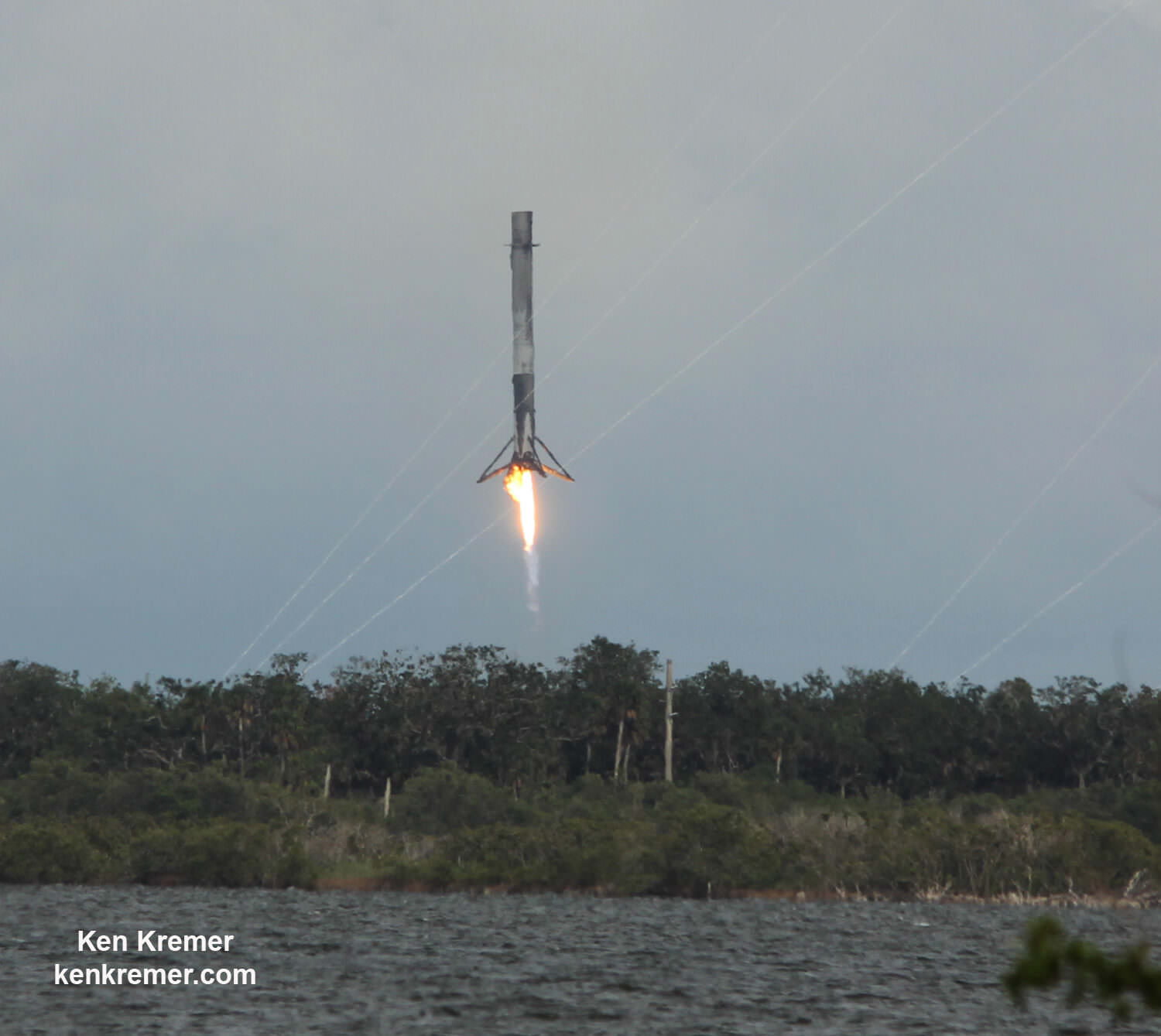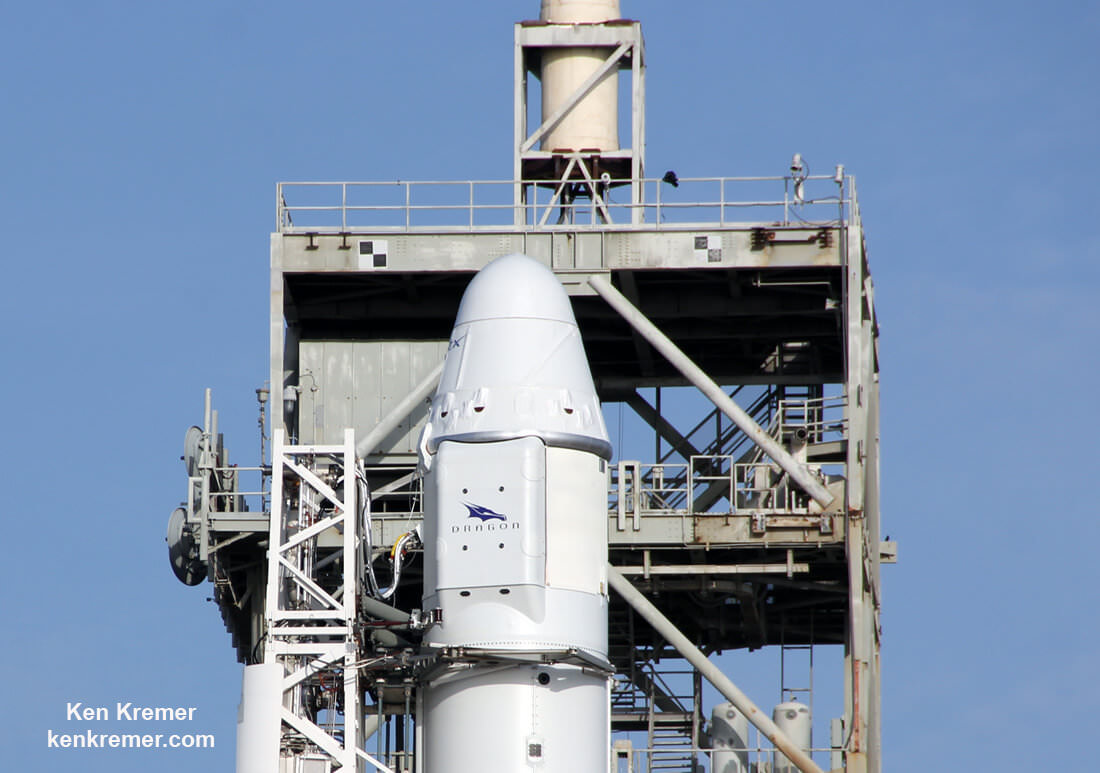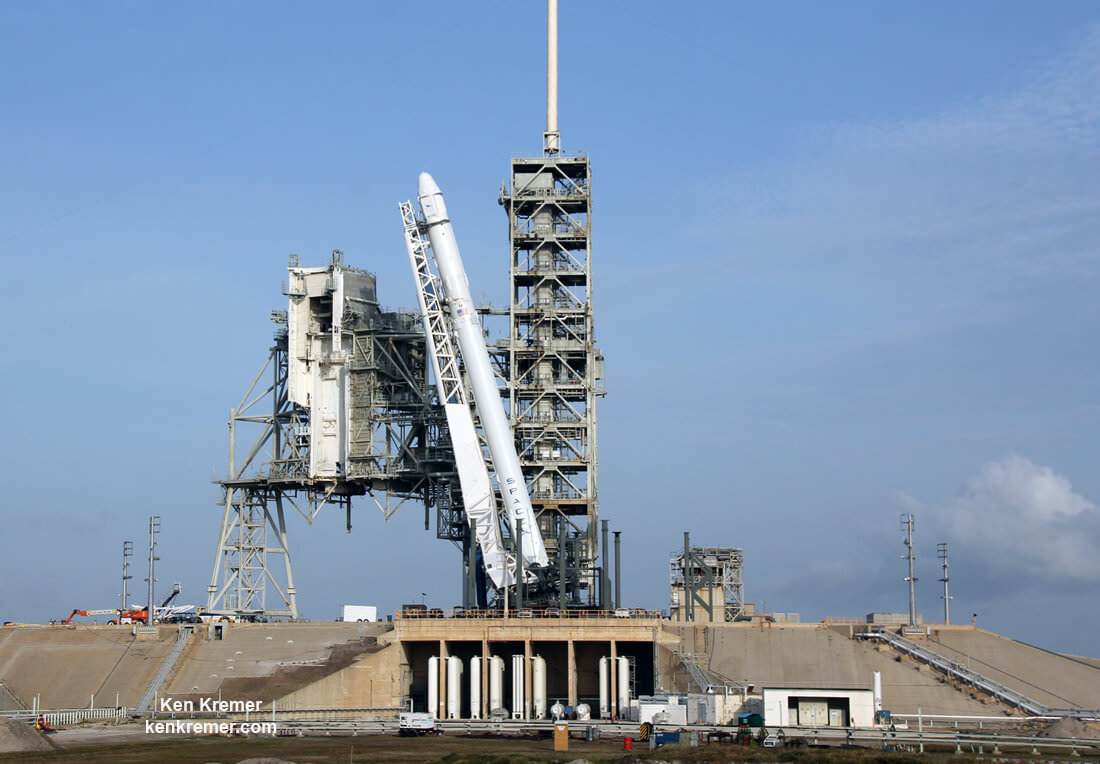
Blastoff of SpaceX Falcon 9 rocket from Launch Complex 39A at the Kennedy Space Center) at 5:07 p.m. EDT on June 3, 2017, on Dragon CRS-11 resupply mission to the International Space Station (ISS) for NASA. Credit: Ken Kremer/kenkremer.com
KENNEDY SPACE CENTER, FL - After threatening stormy skies over the Florida Space Coast miraculously parted just in the nick of time, the first ever recycled SpaceX Dragon cargo freighter blasted off on the 100th flight from historic pad 39A on the Kennedy Space Center (KSC) - bound for the International Space Station (ISS) and loaded with a science rich cargo for the multinational crew late Saturday afternoon June 3.
Nearly simultaneously the first stage booster accomplished another heart stopping and stupendous ground landing back at the Cape accompanied by multiple shockingly loud sonic booms screeching out dozens of miles (km) in all directions across the space coast region.

SpaceX Falcon 9 booster deploys quartet of landing legs moments before precision propulsive ground touchdown at Landing Zone 1 on Canaveral Air Force Station barely nine minutes after liftoff from Launch Complex 39A on 3 June 2017 from the Kennedy Space Center in Florida on the Dragon CRS-11 resupply mission to the International Space Station for NASA. Credit: Ken Kremer/Kenkremer.com
Liftoff of the SpaceX Falcon 9 rocket carrying the unmanned Dragon cargo freighter from seaside Launch Complex 39A at KSC in Florida took place during an instantaneous launch window at 5:07 p.m. EDT Saturday, June 3, after a predicted downpour held off just long enough for the SpaceX launch team to get the rocket safely off the ground.
The launch took place after a 48 hour scrub from Thursday June 1 forced by stormy weather and lightning strikes came within 10 miles of pad 39A less than 30 minutes from the planned liftoff time.
The backup crew of 40 new micestonauts are also aboard for a first of its kind osteoporosis science study - that seeks to stem the loss of bone density afflicting millions of people on Earth and astronauts crews in space by testing an experimental drug called NELL-1. The 40 originally designated mice lost their coveted slot and were swapped out Friday due to the scrub.
The 213-foot-tall (65-meter-tall) SpaceX Falcon 9 roared to life off pad 39A upon ignition of the 9 Merlin 1 D first stage engines generating 1.7 million pounds of liftoff thrust and successfully delivered the Dragon bolted on top to low Earth orbit on course for the space station and jam packed with three tons of essential cargo.
Loading of the densified liquid oxygen and RP-1 propellants into the Falcon 9 first and second stages starting about 70 minutes prior to ignition. Everything went off without a hitch.
The 20-foot high, 12-foot-diameter Dragon is carrying almost 5,970 pounds of science experiments and research instruments, crew supplies, food water, clothing, hardware, gear and spare parts to the million pound orbiting laboratory complex in support of Expedition 52 and 53 crew members.

Up close view of SpaceX Dragon CRS-11 resupply vessel atop Falcon 9 rocket and delivering 3 tons of science and supplies to the International Space Station (ISS) for NASA. Liftoff slated for 1 June 2017. Credit: Ken Kremer/Kenkremer.com
Dragon CRS-11 marks SpaceX's eleventh contracted commercial resupply services (CRS) mission to the International Space Station for NASA since 2012.
Falcon 9 streaked to orbit in spectacular fashion darting in and out of clouds for the hordes of onlookers and spectators who had gathered from around the globe to witness the spectacle of a rocket launch and booster landing first hand.
Dragon is loaded with "major experiments that will look into the human body and out into the galaxy."
The flight will deliver investigations and facilities that study neutron stars, osteoporosis, solar panels, tools for Earth-observation, and more.
The unpressurized trunk of the spacecraft also will transport 3 payloads for science and technology experiments and demonstrations.
The truck payloads include the Roll-Out Solar Array (ROSA) solar panels, the Multiple User System for Earth Sensing (MUSES) facility which hosts Earth-viewing instruments and tools for Earth-observation and equipment to study neutron stars with the Neutron Star Interior Composition Explorer (NICER) payload.
NICER is the first ever space mission to study the rapidly spinning neutron stars - the densest objects in the universe. The launch coincidentally comes nearly 50 years after they were discovered by British astrophysicist Jocelyn Bell.
If all goes well, Dragon will arrive at the ISS 2 days after launch and be grappled by Expedition 52 astronauts Peggy Whitson and Jack Fischer using the 57 foot long (17 meter long) Canadian-built robotic arm.
They will berth Dragon at the Earth-facing port of the Harmony module.
Overall CRS-11 marks the 100th launch from pad 39A and the sixth SpaceX launch from this pad.
SpaceX leased pad 39A from NASA in 2014 and after refurbishments placed the pad back in service this year for the first time since the retirement of the space shuttles in 2011. To date this is the sixth SpaceX launch from this pad.
Previous launches include 11 Apollo flights, the launch of the unmanned Skylab in 1973, 82 shuttle flights and five SpaceX launches.

SpaceX Falcon 9 rocket goes erect to launch position atop Launch Complex 39A at the Kennedy Space Center on 1 Jun 2017 as seen the morning before later afternoon launch from inside from the pad perimeter. Liftoff of the CRS-11 resupply mission to the International Space Station (ISS) slated for 1 June 2017. Credit: Ken Kremer/Kenkremer.com
Watch for Ken's onsite CRS-10 mission reports direct from the Kennedy Space Center and Cape Canaveral Air Force Station, Florida.
Stay tuned here for Ken's continuing Earth and Planetary science and human spaceflight news.
Ken Kremer
No comments:
Post a Comment